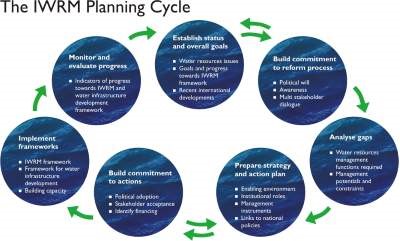Water policy and management need to reflect the fundamentally interconnected nature of hydrological resources, and IWRM is the accepted alternative to the sector-by-sector, top-down management style that has dominated the past. The basis of IWRM is that the many different uses of water resources are interdependent. For example, high irrigation demands and polluted drainage flows from agriculture mean less freshwater for drinking or industrial use; contaminated municipal and industrial wastewater pollutes rivers and threatens ecosystems; if water has to be left in a river to protect fisheries and ecosystems, less can be diverted to grow crops.
The IWRM principles adopted at the International Conference on Water and the Environment in Dublin, Ireland, in 1992, are known as the Dublin Principles:
- Fresh water is a finite and vulnerable resource, essential to sustain life, development and the environment
- Water development and management should be based on a participatory approach, involving users, planners and policy-makers at all levels
- Women play a central part in the provision, management and safeguarding of water
- Water has an economic value in all its competing uses and should be recognized as an economic good
These principles were later summarized by GWP:
Integrated water resources management is based on the equitable and efficient management and sustainable use of water and recognises that water is an integral part of the ecosystem, a natural resource, and a social and economic good, whose quantity and quality determine the nature of its utilisation.
This emphasizes the importance of an integrated approach as well as clearly articulating the link between water resources management and the “3Es” of sustainable development: economic efficiency in water use, social equity, and environmental and ecological sustainability.
An IRWM approach focuses on three pillars:
- an enabling environment of suitable policies, strategies and legislation for sustainable water resources development and management,
- putting in place the institutional framework through which to put into practice the policies, strategies and legislation, and
- setting up the management instruments required by these institutions to do their job.
 IWRM should be viewed as a process rather a one-shot approach -one that is long-term and forward-moving but iterative rather than linear in nature.
IWRM should be viewed as a process rather a one-shot approach -one that is long-term and forward-moving but iterative rather than linear in nature.
There is not one correct administrative model. The art of IWRM lies in selecting, adjusting, and applying the right mix of tools for a given situation. Agreeing on milestones and timeframes is critical for success. Implementation may take place on a step-by-step basis, in terms of geographical scope and the sequence and timing of reforms. Scope, timing, and content of measures can be adjusted according to experience. In developing a strategy and framework for change, it is important to recognize that the process of change is unlikely to be rapid.
For policy-making and planning, applying an integrated approach requires that:
water development and management takes into account the various uses of water and the range of people’s water needs;
- stakeholders are given a voice in water planning and management, with particular attention to securing the involvement of women and the poor;
- policies and priorities consider water resources implications, including the two-way relationship between macroeconomic policies and water development, management, and use;
- water-related decisions made at local and basin levels are along the lines of, or at least do not conflict with, the achievement of broader national objectives; and
- water planning and strategies are incorporated into broader social, economic, and environmental goals.


